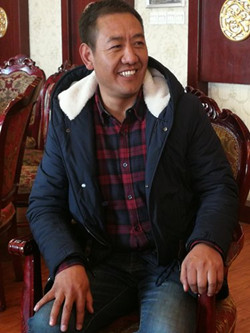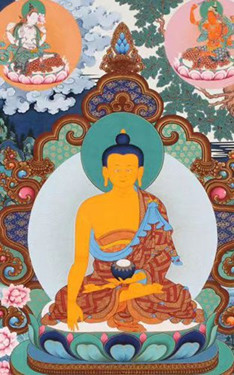

“From 300 to 3,000 (roughly), the rise in the number of Thangka painters in Tibet shows that religious art is thriving and a perfect example of the government’s support to Tibet culture,” Norbu Sitar, dean of the Tibet Thangka Painting Academy in Lhasa, said.

Norbu Sitar Photo: Cao Siqi/Global Times
A national-level cultural inheritor of Thangka and a Chinese Crafts and Artisan Master, China’s top honor title issued by State Council to craft artists, he came to Beijing with a mission.
As a member of the Chinese People’s Political Consultative Conference (CPPCC), he attended the two sessions to promote the “status” of Thangka.
Thangka paintings, or scroll paintings on cotton or silk, was originated more than 1,300 years ago. They were traditionally kept unframed and rolled up when not on display. The themes of Thangka are mostly about Buddhism, legendary and folk tales, and historical stories.
“With central and regional government support, the number of Thangka painters have been increasing in recent years and their skills have also improved.” Norbu Sitar said.
One of his works has been preserved in the Potala Palace, a World Heritage site in Lhasa, and his academy is receiving huge government funding.
“Thangka is not only thriving in China, but also drawing the attention of collectors in the US, the UK and Denmark,” he said, adding that to prevent it from over-commercialization, Thangka inheritors are thinking of a national standard for the industry.

Thangka painted by Norbu Sitar Photo: Courtesy of Norbu Sitar
Lhapa, also a CPPCC member from the Jokhang Monastery Temple, recently told news site tibet.cn that the temple has established a Buddha and Thangka database and has included more than 6,000 Buddha statues and 600 Thangka paintings into the database.
In response to accusations from overseas media that many Tibetans blame China for wanting to dilute their culture and that Tibet is the victim of "cultural genocide," Norbu Sitar laughed.
“The number and skills say everything,” he said.
 Fire brigade in Shanghai holds group wedding
Fire brigade in Shanghai holds group wedding Tourists enjoy ice sculptures in Datan Town, north China
Tourists enjoy ice sculptures in Datan Town, north China Sunset scenery of Dayan Pagoda in Xi'an
Sunset scenery of Dayan Pagoda in Xi'an Tourists have fun at scenic spot in Nanlong Town, NW China
Tourists have fun at scenic spot in Nanlong Town, NW China Harbin attracts tourists by making best use of ice in winter
Harbin attracts tourists by making best use of ice in winter In pics: FIS Alpine Ski Women's World Cup Slalom
In pics: FIS Alpine Ski Women's World Cup Slalom Black-necked cranes rest at reservoir in Lhunzhub County, Lhasa
Black-necked cranes rest at reservoir in Lhunzhub County, Lhasa China's FAST telescope will be available to foreign scientists in April
China's FAST telescope will be available to foreign scientists in April "She power" plays indispensable role in poverty alleviation
"She power" plays indispensable role in poverty alleviation Top 10 world news events of People's Daily in 2020
Top 10 world news events of People's Daily in 2020 Top 10 China news events of People's Daily in 2020
Top 10 China news events of People's Daily in 2020 Top 10 media buzzwords of 2020
Top 10 media buzzwords of 2020 Year-ender:10 major tourism stories of 2020
Year-ender:10 major tourism stories of 2020 No interference in Venezuelan issues
No interference in Venezuelan issues
 Biz prepares for trade spat
Biz prepares for trade spat
 Broadcasting Continent
Broadcasting Continent Australia wins Chinese CEOs as US loses
Australia wins Chinese CEOs as US loses